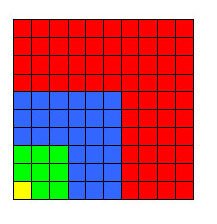- About MAA
- Membership
- MAA Publications
- Periodicals
- Blogs
- MAA Book Series
- MAA Press (an imprint of the AMS)
- MAA Notes
- MAA Reviews
- Mathematical Communication
- Information for Libraries
- Author Resources
- Advertise with MAA
- Meetings
- Competitions
- Programs
- Communities
- MAA Sections
- SIGMAA
- MAA Connect
- Students
- MAA Awards
- Awards Booklets
- Writing Awards
- Teaching Awards
- Service Awards
- Research Awards
- Lecture Awards
- Putnam Competition Individual and Team Winners
- D. E. Shaw Group AMC 8 Awards & Certificates
- Maryam Mirzakhani AMC 10 A Awards & Certificates
- Two Sigma AMC 10 B Awards & Certificates
- Jane Street AMC 12 A Awards & Certificates
- Akamai AMC 12 B Awards & Certificates
- High School Teachers
- News
You are here
Sums of Powers of Positive Integers - Solutions to Exercises 7-8
Exercise 7.

Figure 18. (1 + 2 + 3 + 4)2 = 13 + 23 + 33 + 43
$$(1 + 2 + 3 + 4)^2 = (1 + 2 + 3)^2 + \left( {2 \cdot 4(1 + 2 + 3) + 4^2 } \right) \quad\quad {\rm (Step\ 1)}$$
$$= (1 + 2 + 3)^2 + \left( {2 \cdot 4{{3 \cdot 4} \over 2} + 4^2 } \right)$$
$$= (1 + 2 + 3)^2 + \left( {4^2 (3 + 1)} \right)$$
$$= (1 + 2 + 3)^2 + 4^3$$
$$= (1 + 2)^2 + \left( {2 \cdot 3(1 + 2) + 3^2 } \right) + 4^3 \quad\quad {\rm (Step\ 2)}$$
$$= (1 + 2)^2 + \left( {2 \cdot 3{{2 \cdot 3} \over 2} + 3^2 } \right) + 4^3$$
$$= (1 + 2)^2 + \left( {3^2 (2 + 1)} \right) + 4^3$$
$$= (1 + 2)^2 + 3^3 + 4^3$$
$$= 1 + (2 \cdot 2 \cdot 1 + 2^2 ) + 3^3 + 4^3 \quad\quad\quad {\rm (Step\ 3)}$$
$$= 1 + (2 \cdot 2^2 ) + 3^3 + 4^3$$
$$(1 + 2 + 3 + 4)^2= 1^3 + 2^3 + 3^3 + 4^3$$
Each cubic term represents a gnomon. In particular, 13, 23, 33, and 43 are, respectively, the areas of the yellow, green, blue, and red gnomons in Figure 18.
Exercise 8. $$1^4 + 2^4 + 3^4 + \cdots + n^4 = {1 \over 5}n^5 + {1 \over 2}n^4 + c_3 n^3 + c_2 n^2 + c_1 n + c_0,$$
where $$c_3 + c_2 + c_1 + c_0 = 1 - \left( {{1 \over 5} + {1 \over 2}} \right) = {3 \over {10}}.$$
Three possible formulas are
$${1 \over 5}n^5 + {1 \over 2}n^4 + {1 \over {10}}n^3 + {1 \over {10}}n^2 + {1 \over {10}}n,$$
$${1 \over 5}n^5 + {1 \over 2}n^4 + {1 \over 5}n^3 + {1 \over {10}}n, \quad {\rm and}$$
$${1 \over 5}n^5 + {1 \over 2}n^4 + {1 \over 5}n^3 + {1 \over {15}}n^2 + {1 \over {30}}n.$$
The correct formula is $$1^4 + 2^4 + 3^4 + \cdots + n^4 = {1 \over 5}n^5 + {1 \over 2}n^4 + {1 \over 3}n^3 - {1 \over {30}}n.$$
Surprised?
Janet Beery (University of Redlands), "Sums of Powers of Positive Integers - Solutions to Exercises 7-8," Convergence (July 2010), DOI:10.4169/loci003284




